Share the post "George Floyd: Protesters set Minneapolis police station ablaze"
A police station in Minneapolis has been set alight during a third night of protests over the death of an unarmed black man in custody on Monday.
A police officer was filmed kneeling on the neck of George Floyd, 46, despite him saying he could not breathe.
President Donald Trump said “thugs” were dishonouring his memory and called on the National Guard to restore order.
The incident has added to anger over police killings of black Americans, including Breonna Taylor in Kentucky.
- In pictures: Protest clashes in Minneapolis
- Viewpoint: Why racism is worse in the US than Europe
- Woman sacked after calling police on black man
Mr Floyd’s family have demanded that the four police officers implicated in his death face murder charges. Prosecutors have said they are still gathering evidence.
A CNN journalist, Omar Jimenez, and his camera crew were arrested live on air by Minnesota state police officers on Friday morning, apparently because they did not move on when instructed.
The team was released an hour later, after the governor apologised for the arrest.Skip Twitter post by @CNN
End of Twitter post by @CNN
There have also been demonstrations in other US cities, including New York, Los Angeles, Chicago, Denver, Phoenix and Memphis.
Twitter accused Mr Trump of glorifying violence in a post that said: “When the looting starts, the shooting starts.”
What is the latest in Minneapolis?
In the last few days, buildings have been burned to the ground or looted.
On Thursday, protesters gathered outside the police department’s 3rd Precinct, the epicentre of the unrest.
Officers fired tear gas and rubber bullets in an attempt to disperse the crowd. But the cordon around the police station, which is near where Mr Floyd died, was breached by protesters, who set fire to it and two other nearby buildings as the officers withdrew.
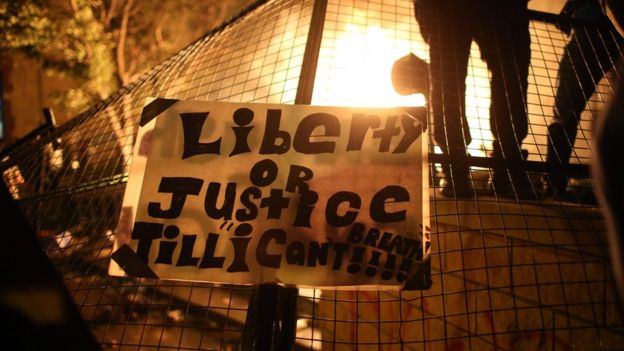
Minneapolis Mayor Jacob Frey said there had been no choice but to evacuate the police station, adding: “The symbolism of a building cannot outweigh the importance of life, of our officers or the public.”
He called the unrest “unacceptable”, but added that he and everyone else recognised there was “a lot of pain and anger”.
He spoke after a tweet from President Donald Trump blamed Thursday’s violence on a “lack of leadership” in Minneapolis and warned that he would send in the National Guard and “get the job done right” if Mr Frey failed to restore order.
National Guard personnel are normally under state control, although they can be put under federal control in emergencies.
Mr Trump also tweeted: “Any difficulty and we will assume control but, when the looting starts, the shooting starts.”
Twitter placed a “public interest notice” on the message, saying it “violates our policies regarding the glorification of violence based on the historical context of the last line, its connection to violence, and the risk it could inspire similar actions”.
The historical context arises from riots in Miami in 1968. A federal task force found that the use of the phrase about looting by the Miami police chief at the time was a prime factor in the discontent that triggered the unrest.
On Friday, the White House Twitter account also quoted the president’s tweet on looting and shooting.
Twitter flagged two of the president’s posts as potentially misleading earlier this week, prompting him to issue an executive order seeking to limit the legal immunity of social media firms.
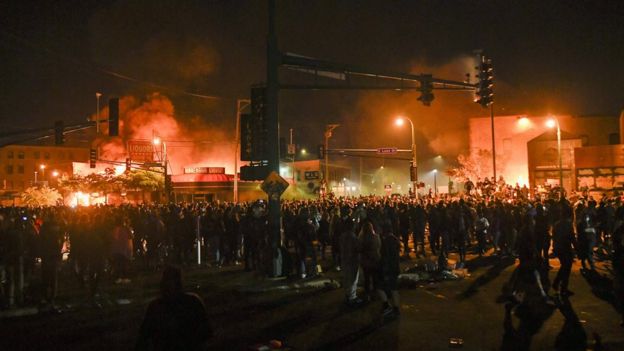
Before the police station was set ablaze, Minnesota Governor Tim Walz had activated the state’s National Guard troops at the request of the mayors of Minneapolis and the neighbouring city of St Paul, declaring the situation a “peacetime emergency”.
He said the looting, vandalism and arson of Wednesday night had resulted in damage to many businesses, including ones owned by minorities.
“George Floyd’s death should lead to justice and systemic change, not more death and destruction,” he said in a statement, calling on all protests to remain peaceful.
What has been the reaction?
Mayor Frey called on Wednesday for criminal charges against the policeman who was filmed pinning down Mr Floyd. The officer and three others involved in the arrest have already been fired.
Mr Floyd’s brother, Philonise, told CNN on Thursday: “I’m never gonna get my brother back.”
Speaking through tears, he said the officers who “executed my brother in broad daylight” must be arrested and that he was “tired of seeing black men die”.
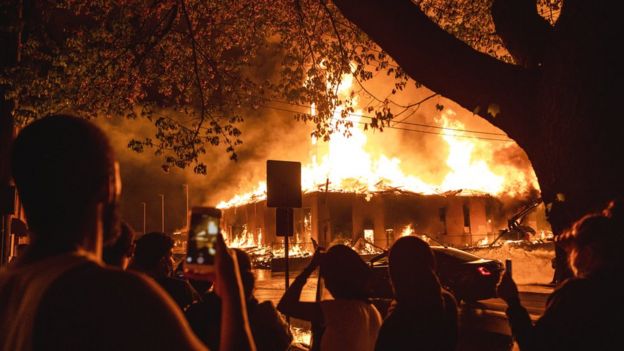
United Nations human rights chief Michelle Bachelet has also condemned Mr Floyd’s death, saying the role of “entrenched and pervasive racial discrimination” must be recognised and dealt with.
President Donald Trump “was very upset” when he saw the footage of Mr Floyd’s death, White House press secretary Kayleigh McEnany told reporters on Thursday. “He wants justice to be served,” she added.
A number of celebrities and athletes, including John Boyega, LeBron James, Beyonce, and Justin Bieber, have also expressed outrage over the incident.
The incident echoes the case of Eric Garner, who was placed in a police chokehold in New York in 2014. His death became a rallying cry against police brutality and a catalyst in the Black Lives Matter movement.
Where else have there been protests?
People also took to the streets in Minneapolis’ twin city, St Paul, on Thursday, where police said multiple fires had been reported.
There were also chaotic scenes during rallies in Denver, Colorado and in Columbus, Ohio.
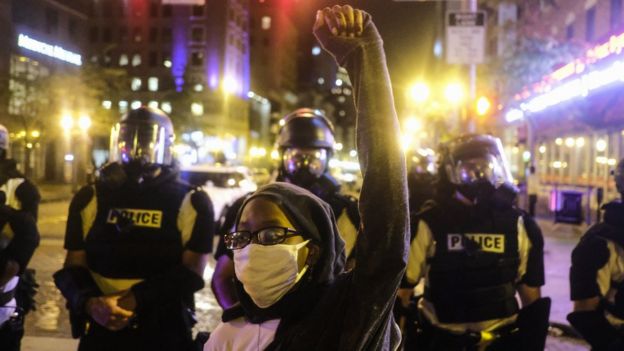
The statehouse in Denver was put under lockdown after gunfire was heard, while in Columbus demonstrators reportedly broke some of the statehouse’s windows before being dispersed by police.
Seven people were also shot in Louisville, Kentucky, at a protest over the death of Breonna Taylor, who was shot by three white police officers in March.
What happened to George Floyd?
Officers responding to reports of the use of counterfeit money approached Mr Floyd in his vehicle on Monday.
According to police, he was told to step away from the car, physically resisted officers and was handcuffed. The police statement noted his apparent “medical distress”.
Video of the incident does not show how the confrontation started.
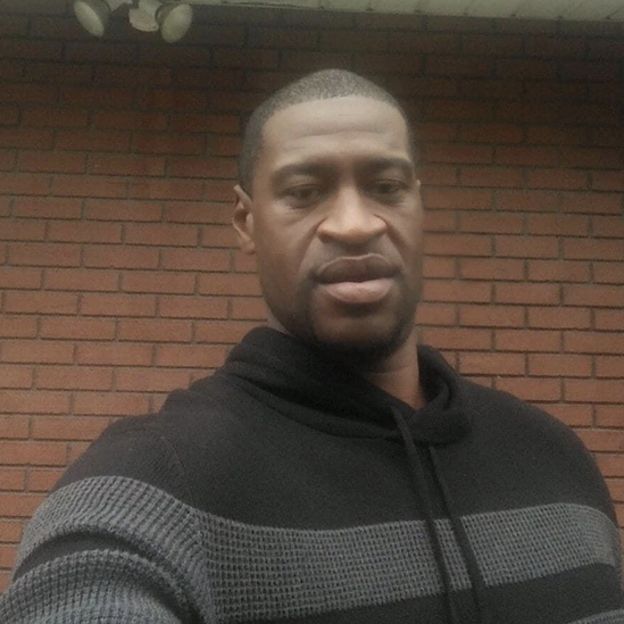
A white officer can be seen using his knee to pin Mr Floyd to the ground by the neck as Mr Floyd groans “please, I can’t breathe” and “don’t kill me”.
The city has identified the four officers involved as Derek Chauvin, Tou Thao, Thomas Lane and J Alexander Kueng.
Local media have named Mr Chauvin as the officer seen with his knee on Mr Floyd’s neck.
The Minneapolis Police Officers’ Federation said the officers were co-operating with the investigation. “We must review all video. We must wait for the medical examiner’s report,” it said in a statement.
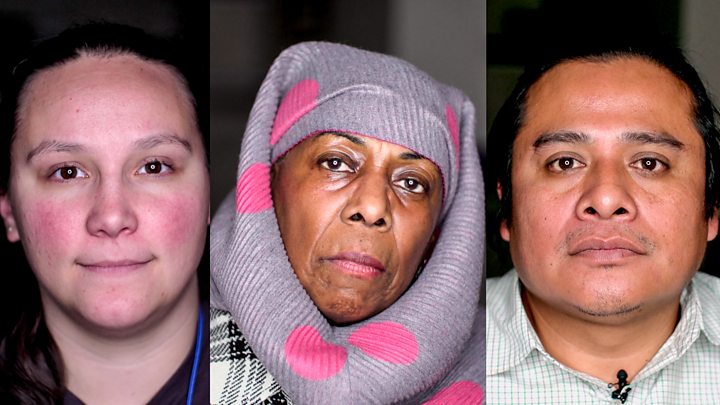
The Minnesota police handbook states that officers trained on how to compress the neck without applying direct pressure to the airway can use a knee under its use-of-force policy. This is regarded as a non-deadly-force option.
bbc